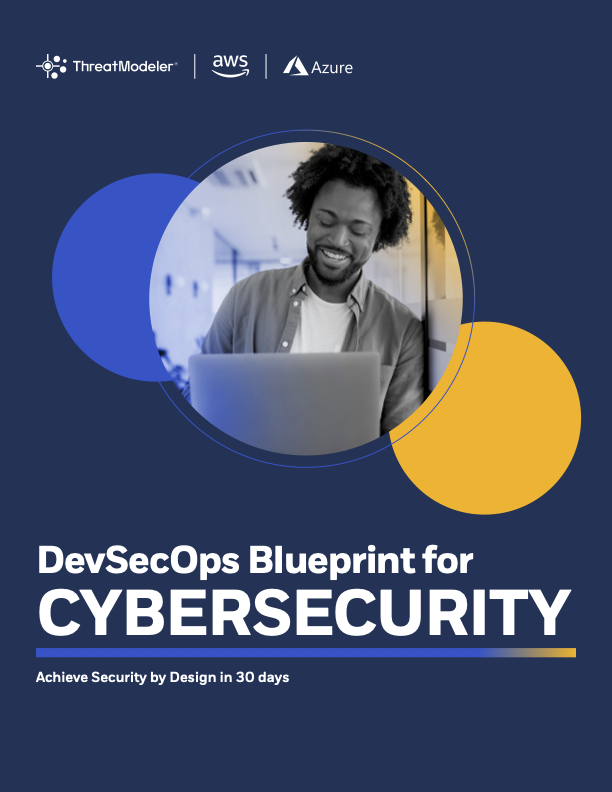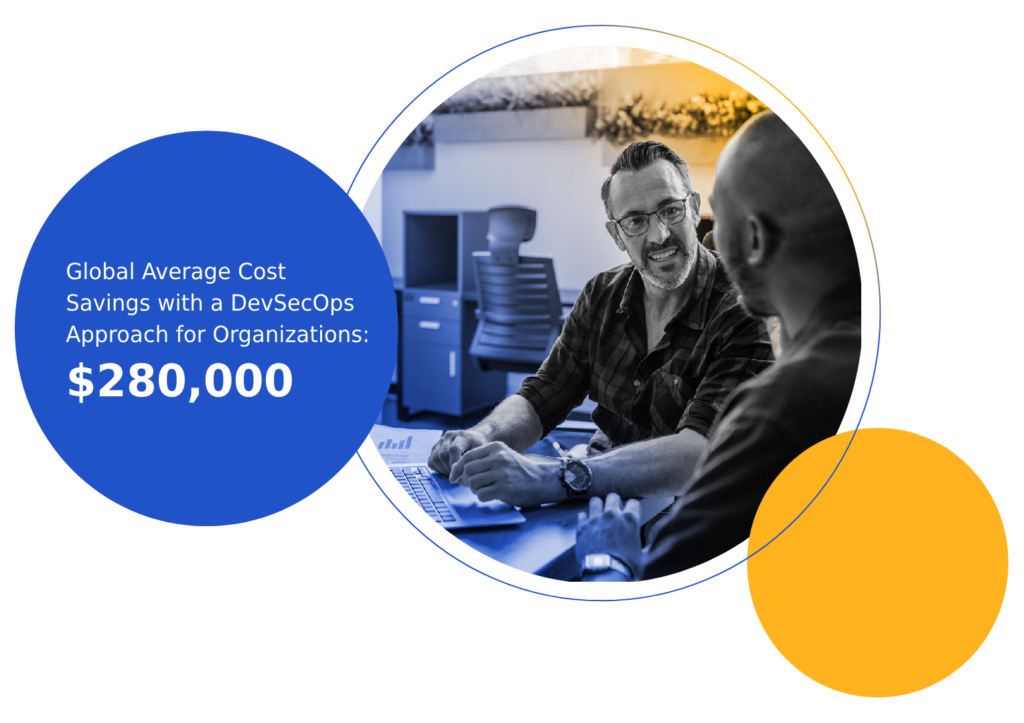Download the
WHITE PAPER
DevSecOps Blueprint for Cyber Security
Increasingly, cybercriminals are finding new ways to compromise the privacy and confidentiality of organizations. Not only are cybercrimes increasing in volume, they are becoming more severe. According to the 2019 Cost of a Data Breach Report (Ponemon Institute, sponsored by IBM Security), there was a 21% increase in data breaches worldwide caused with malicious or criminal intent. Taking steps to implement a robust cybersecurity program will help an organization to protect the data it processes. By strengthening an organization’s cybersecurity posture, CISOs can prevent data breaches, ensure business continuity and save on overall costs.
This White Paper will explain how organizations are developing application workloads in their cloud deployment and benefiting. We will also provide a road map to transition to DevSecOps within the cloud. This White Paper will also reveal how to:
– Apply DevSecOps to the entire CDLC
– Integrate a comprehensive, inclusive DevSecOps program
– Introduce tools that automate your DevSecOps program
Read the full white paper below or download it now

The concept of DevOps began in 2008, and is lean by approach
Within DevOps engineering, developers apply the agile methodology in small, but frequent development iterations. DevOps enables programmers to work in a testable environment that mirrors the operations environment. The DevOps deployment framework can exist via on-premise, private cloud, public cloud or hybrid.
What is DevOps?
DevOps teams have security demands that need to be met due to compliance, or promises made to customers for particular levels of security. In addition to enabling continuous integration and continuous development (CI/CD), the benefits of DevOps include:
Speed and rapid deployment, including time-to-market
More stable, more reliable operating environments
Reduced new release failure rate
Higher quality output
More time devoted to achieve business objectives, including innovation
Less time needed for downtime, recovery, maintenance and bug fixes

More Organizations are Migrating to the Cloud
DevSecOps is Replacing DevOps as the Preferred Approach
The software development climate is constantly changing as more organizations migrate to the cloud. Cloud-based application development, also known as the cloud development life cycle (CDLC), is paving the way for organizations to easily scale, e.g., meet peak data processing demands. CDLC offers a flexible place to store content. In most cloud provider arrangements, you pay for what you need, making scalability more accessible as your organization grows. CDLC also enables developers and cloud security architects (CSAs) to more easily manage updates, bug fixes and improvements with as little downtime as possible. Based on your needs, you can opt for:
1. Private cloud
An entire cloud solution that is allocated to a single organization’s data, with the data either
stored on-premise or offsite through a third-party Cloud Service Provider (CSP). Private cloud offers more
control, for example,over cloud protocols, configurability and metrics.
2. Public cloud
Each public cloud customer has their own service level agreements(SLAs) with the CSP. In this
instance, CSPs are responsible for the security “of” the cloud and the customer is responsible for the security “in”
their cloud. Public cloud clients benefit from the elasticity needed to adjust to workflow demands.
3. Hybrid cloud
A mix of private and public clouds, hybrid cloud stores data on-premise and off-site. Hybrid
enables enterprises to exert more control, such as with private SaaS customers, who require that data be
kept in private clouds. While extra control is an added benefit, configuration and integration issues may come
into play depending on the complexity of IT infrastructure.
“Due to its elasticity, CDLC enables developers and cloud security architects (CSAs) to more easily manage updates, bug fixes and improvements with as little downtime as possible.”
Security and Compliance Become Primary Enforcement Objectives
That’s where DevSecOps comes in. Within DevSecOps, security and privacy measures are administered throughout the entire CDLC process. DevSecOps helps to foster engagement and collaboration across the enterprise.
-
Plan
Define business objectives and requirements.
Determine business metrics. Establish the security
policy and requirements. -
Code
Design the software and create the application code. Automate certain developer code activities such as: compliance, infrastructure, security and testing.
-
Build
Oversee software builds, including version control.Compile, package and store code for future production release. Developers also package infrastructure components in code or package repositories that will be used in product release.
-
Test
Ensure that the software is built to meet the highest quality standards. Types of testing include acceptance testing,regression testing, configuration testing,and security threat analysis.
-
Deploy
Manage the software release, including coordinating and scheduling the release into production. Automation helps to schedule a release timeline into the targeted environment.
-
Operate
After release, developers manage software during production. Provisioning and configuring occur as needed to infrastructure, databases, networks and applications.
-
Monitor
Users across the organization provide feedback about software issues. Developers review issues related to specific releases for their impact on end-users. Documentation is an important step in monitoring, as infrastructure performance, end user experience and other metrics are recorded. This information is often used to influence Plan activities for updates and new release cycles.
Secure by Design: Security Should be Built into the Code
Secure by design is a concept asserting that security should be built-in from the foundation, i.e., as early as the planning stages. Rather than reacting to an outage or data breach, developers will spend their time implementing preventive measures. For example, designers will look for potential threats and attack vectors that contribute to an organization’s risk.
Examples of threats include security design flaws, code defects and code imperfections. DevSecOps introduces shift-left practices to better secure an organization’s IT infrastructure from its foundation. Shift left entails implementing security earlier in the software development process rather than towards the end. Within the shift-left approach, consider the sensitive and proprietary enterprise information plus the personally identifiable information (PII) of your customers.
An organization that has implemented DevSecOps will code security into their systems and applications, whether they are on-premise or in the cloud. The DevSecOps approach benefits an organization by:
-
Introducing design constraints, which leave less room for error
-
Addressing design flaws and code weaknesses that contribute to risk
-
Removing silos
-
Reducing the need for patches and bug fixes
-
Minimizing the impact of security risk
-
Maximizing system and application uptime
-
Increasing focus on strategy and innovation
Security by design is more prominent than ever as organizations implement strategies to become as resilient and resistant in their cloud to cyberattacks, old, new and emerging.
Cloud DevSecOps
When Everyone at Every Level Is Involved in Security
DevSecOps cal ls for greater collaboration, starting at the top and working its way to the bottom within an organization. It is important to maintain collaboration between developers, business owners, operations and project managers. Stakeholder engagement is crucial.
DevSecOps requires the writing of code that manages, automates and enforces policy. As part of the planning stages, collaborators can partake in processes to maximize their understanding of security threats and risks:
-
Risk Assessment
Identify the information assets within an organization (laptops, login credentials, customer data and servers), and the various threats that put them at risk of a data breach or cyberattack.
-
Threat Modeling
By using process flow diagrams, security teams can threat model their infrastructure to better understand information assets, how they are managed and secured, plus the threat vectors that may impact them. Threat modeling is an important part of security by design.
-
Maximize Throughput
Key stakeholders can take risk assessment and threat modeling results and, armed with a full view of the security and compliance posture, make data-driven results more quickly. Risk management decision making includes steps to mitigate, remediate or explain accepted risk.
After identifying risk during planning, DevSecOps collaborators work together to enforce secure code writing, implement security controls and manage security checks throughout the CI/CD pipeline. Collaboration ensures that checks and balances are in place to make sure an organization is compliant with internal policy and external regulations. This includes restricting access (such as through the least privilege model), continuous monitoring (with reporting), and keeping applications updated with the latest versions containing patches and bug fixes. Cloud security architects and developers work hand-in-hand to ensure security controls are implemented throughout the CDLC process. Validation occurs through reporting and documentation designed for CISO sign-off, checking against compliance rules, mitigated threats, backlog.
Increased deployment frequency with low-risk releases
Shortened lead times
Increased threat detection
Trust, improved relationships
within the organization
Empowered monitoring

Global Average Data Breach
Cost to Organisations: $3.92 Million
Automation also Lends Itself
to Security by Design
Users can validate security controls by logging into their AWS cloud system and make surreal controls are implemented. ThreatModeler Cloud Edition includes a new feature that continuously monitors threat models, allowing users to certify the controls are implemented and they can be aware of any changes and updates. Users can review those changes and incorporate them to a new version of their current threat model.
Version control
(GitHub, AWS CodeCommit, Microsoft Team Foundation Server)
Continuous integration, testing and monitoring
(Jenkins for CI, IBM Rational Functional Tester, Jira for defect tracking)
Configuration and provisioning
(Ansible,CFEngine, Chef)
Orchestration
(Microsoft Azure Cloud Management, BMC Control M, CA Workload Automation)
Threat modeling became a prominent part of understanding information security threats beginning in 2011. Typically a manual, ad hoc process, advancements in threat modeling have made it an integral, necessary process in DevSecOps. Threat modeling helps to ensure that security is applied earlier rather than later, empowering organizations to better understand their attack surface and mitigate security risk.
CISOs and stakeholders will benefit from threat modeling, which enables them to fully understand the security threats that impact their infrastructure and applications. ThreatModelerTM is the industry’s leading threat modeling tool, with automation features that make it well-suited to integrate within your DevSecOps driven CDLC.
ThreatModeler Uses the VAST Methodology Approach
Visual, Agile, Simple Threat modeling (VAST) represents the most comprehensive, clean and concise format. VAST utilizes process flow diagramming to deconstruct system or application architecture, which can help you to understand the different security threats from the perspective of a hacker. Since threat modeling enables you to better understand and document security threats, the activity helps DevSecOps teams to prioritize risk.
Threat modeling is a key, essential activity in shifting security left in the cloud. With the right application, you can improve security, contribute to ease of collaboration and scale across the enterprise. A person with little-to-no technical skills can create an accurate ThreatModeler process flow diagram. Users can review existing threats, keep abreast of new and emerging threats, and implement security requirements and controls to mitigate threats.
ThreatModeler seamlessly integrates with third-party pipeline tools to stay up-to-date with threats. ThreatModeler features a bidirectional API, for synchronization with CI/CD pipeline solutions such as Jira and Jenkins. ThreatModeler integrates seamlessly with third party business systems to build and test software projects.
Technology Partners:
ThreatModeler and AWS
The platform’s fully-integrated AWS Assist feature enables you to create complete, accurate process flow diagrams that capture and map out AWS application deployments. It’s AWS Accelerator accurately simulates and mirrors what is in the AWS environment. ThreatModeler also features continuous monitoring for material changes in your Amazon Virtual Private Cloud (VPC). It completely checks for newly placed or modified AWS process flow diagram components. In addition, AWS Assist automatically creates new tasks in the Task Pane to notify users of AWS deployment requirements.
ThreatModeler, integrated with AWS IAM, AWS SSM and AWS Security Hub, enables CSAs to enforce policy governance that is based on the least privilege model of access. For example, CSAs can review groups and individuals assigned to groups, then specify who is allowed to access what data resources and under what conditions.
At enterprise scale, a huge number of human users accessing multiple tools need permissions. CDLC and microservice-based applications add to the complexity. ThreatModeler provides CSAs with a simulated environment to visualize policy changes, see how the changes will impact the IT environment and make secure access management decisions.
Additionally, the ThreatModeler integration with AWS SSM provides CSAs with data that is linked to the software used. With the information, CSAs can push threat mitigation as individual tasks through IT project management tools such as Jira. ThreatModeler’s dashboard provides a quick overview of an organization’s top threats. Users can dive deeper to better understand the threats and security requirements that will address them.
ThreatModeler’s reporting module helps DevSecOps team members to view and share important information about their attack surface, including:
Executive Summary
Requirements
Identified Threats
Test Cases
Listing of Linked Projects
Data Exposure
Components
Conclusion
Automation whenever possible will enable continuity and repeatability with crucial processes, providing a holistic visualization of the attack surface and accurate audit trails. Continuous collaboration on shared processes throughout the CDLC will foster a business process driven by ongoing security decisions. As you integrate automation across the organization, scale down on manual processes, freeing up resources to focus on accelerating productivity. The less humans are involved in doing the work, the more they can focus on other tasks, such as innovating and delivering high-quality applications.
Scalability is an important feature for organizations to leverage if they are making the transition to the cloud. With scalability, programmers can adjust output according to storage and/or capabilities. Developers can engineer containers — say, in the AWS cloud — with automated security activities, such as closing off compromised servers, redirecting traffic and notifying CISOs of a breach.
Threat modeling is an essential activity that helps DevSecOps teams to pinpoint security threats and the security controls that mitigate security risk. The industry leading tool easily integrates with your cloud and CI/CD toolchain. ThreatModeler can help entire organizations to shift left and achieve end-to-end security throughout their technology development life cycles.
Transition to DevSecOps in 30 Days
| ACTIVITY | ACTIVITY ADDITIONAL DETAILS |
|---|---|
| Conduct a company-wide data and asset inventory of: operating systems, software, owners and administrators, locations (e.g. of hardware) and logical addresses. Categorize assets according to sensitivity level. | The information captured will inform your security decisions. Tools and resources that contain this information include: penetration testing tools, software operating licenses, and infrastructure devices. |
| Assemble your DevSecOps team. | Include CISOs, business owners, stakeholders, security specialists and software developers. Make sure to align everyone on core business objectives, including the integration of end-to-end security. Ensure each team member is security minded, and knows their roles and responsibilities as they pertain to DevSecOps. |
| Establish policies and procedures according to your cybersecurity needs. | If your organization already has infosec policies in place, set a regular evaluation schedule for continual improvement. Ensure policies are followed and maintained. |
| Implement or improve upon an organization-wide cybersecurity training program. | Enforce security protocol throughout the entire organization in all areas. |
| Planning: Gather your requirements with security and compliance in mind. | Requirements will be functional and technical. Security requirements should address risk management issues — not only internally, e.g., confidential documents with proprietary information, but also to protect the personally identifiable information (PII) of consumers. |
| Set metrics and benchmark them to measure your information security maturity level. | The US General Services Administration agency has outlined metrics that should be implemented as part of your SDLC. The more security built into your technology development life cycle, the more you can focus on other processes, such as quality improvement and innovation. |
| Automate core security tasks earlier in the CDLC and wherever possible. | Automation of recurring tasks will reduce human error, harden IT systems and applications throughout the CI/CD pipeline and enable you to allocate resources to other activities. |
| Enable automated continuous security testing within the CI/CD pipeline. | Continuous security testing occurs when DevSecOps teams test for bugs and defects whenever a change is made. After adopting continuous security testing, you will have more secure code, hardened infrastructure and more efficient, higher quality development life cycle output. |
| Code security in whenever possible. | Security controls should be coded in that adhere to the cybersecurity triad of confidentiality, integrity and availability (CIA). |
| Implement continuous monitoring and logging. | Make sure security measures are enforced through proactive monitoring, detection and analysis. Continuously monitor feedback for improvement opportunities. Cybersecurity feedback examples include user access restriction levels, number of known attack surface vectors, and meantime- to-detect (and respond). |


